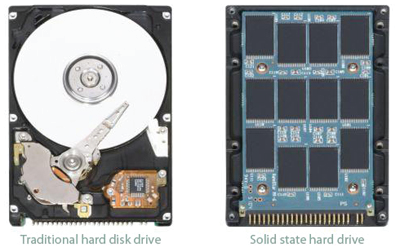Solid State Hard Drives
USB jump or flash drives have quickly become a preferred method for storing, transporting, and backing up large amounts of computer data. They're fast, use little power, and since they have no moving parts, promise many years of trouble-free operation.
Now, as solid state capacities continue to increase and costs decline, Solid State Drives (SSD's) are starting to compete with traditional hard drives as the primary storage device for desktop and laptop computers.
Compared to mechanical/electrical hard drives, SSD are incredibly fast. Boot-up times for desktop and laptop computers can drop to 10 seconds or less, compared to startup times of 1-2 minutes where traditional hard drive technology is used. Programs appear to load instantly, and switching from one program to another occurs with almost zero lag time.

SSD's are physically packaged to be the same size and use the same connections as the traditional drives they replace. So, you can literally pop-out your old drive, plug in an SSD, and after reinstalling Windows and your operating programs, enjoy a computer that's super responsive, quieter, and uses less power (most SSD's are sized for notebook computer use, so you'll need a mounting bracket to fit these 2.5 inch drives into a standard 3.5 inch desktop computer slot).
Unfortunately, the downsides need to be considered. SSD's are still expensive compared to traditional hard drives, and capacities are limited. While prices are dropping fast, expect to spend between 50 cents and $1 per gigabyte for an SSD, compared to 10 cents or less for a traditional hard drive (so $100 will get you a one-terabyte hard drive or a 128 gigabyte SSD).
More important is the matter of SSD life. An overlooked fact is that solid state devices, including USB jump drives, have a limited life span. Each storage location can only be written to a certain number of times, albeit it many thousands of times (there is no limit to how many times a location can be read). For a USB drive that may only be written to a few times a day, this translates into a life span of 20 or more years. But, an SSD employed as a computer system drive can save data hundreds or thousands of times on a daily basis, which reduces the life of the unit to as low as 3-5 years.
SSD manufacturers utilize different strategies to try to extend SSD life, and you can expect new technologies to improve both SSD life and capacities. Still, be aware of these limitations before jumping into SSD technology. When sizing an SSD drive, try to use no more than 50 percent of the unit's rated capacity (one of the 'tricks' used to extend SSD life is to spread written data evenly among unused areas to prevent some spots from 'wearing out' much sooner than others). Keep your traditional hard drive installed as a secondary device for storing information that changes very frequently, such as temporary files.
Like other new technologies, Solid State Drives promise a revolutionary leap over previous systems. While this is most definitely the case, also be aware of the potential limitations and dangers in using SSD drives in your computer system.
Erie County Bar Association
www.eriebar.com
Tips provided by Richard D. Vasil, Vasil Consulting, Inc.
© 2012 Vasil Consulting, Inc.




